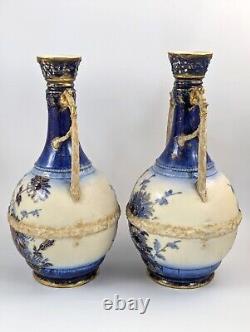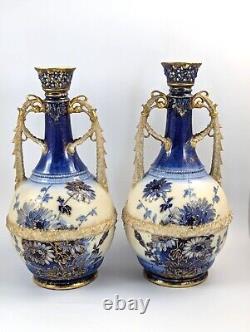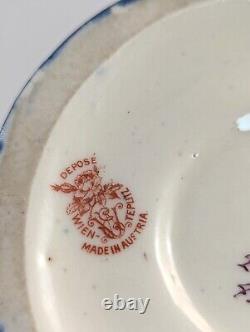
- Homepage
- Culture
- Material
- Bone China (7)
- Brass (6)
- Brass, Porcelain (3)
- Bronze (2)
- Ceramic (17)
- Ceramic & Porcelain (34)
- Ceramic / Porcelain (25)
- Ceramic / Pottery (4)
- Ceramic, Porcelain (40)
- China / Porcelain (16)
- Glass (3)
- Metal (8)
- Ormolu (2)
- Porcelain (1138)
- Porcelain / China (125)
- Porcelain, Cut Steel (3)
- Porzellan (4)
- ... (3392)
- Shape
- Style
- Theme
- Type
- Bowl (20)
- Boxes (15)
- Brooch (21)
- Collector Plate (28)
- Cup & Saucer (27)
- Decorative Plate (23)
- Figurine (257)
- Figurines & Statues (21)
- Lamps (19)
- Painting (14)
- Plaque (41)
- Plate (49)
- Plates (25)
- Plates & Chargers (22)
- Table Lamp (34)
- Trinket Box (16)
- Trio (22)
- Urn (14)
- Vase (298)
- Vases (30)
- ... (3833)
Antique Porcelain Hand Painted Vases by Ernst Wahliss, c. 1910
















A couple of antique Viennese amphora vases, crafted by Ernst Wahliss circa 1910, showcases exquisite craftsmanship and intricate detailing, reflective of early 20th-century Austrian porcelain artistry. The vases features a blush ivory background adorned with delicate blue and gold floral patterns, predominantly asters that are finely hand-painted and outlined in gold. The top are reticulated-decoratively pierced-adding complexity to the design.
Each floral motif is piped with gilding and further enhanced with gold drops, giving the surface a subtle, three-dimensional texture. The vases relief decoration, particularly the braided gold band at the center, provides additional depth and tactile quality. This element showcases the labor-intensive porcelain techniques employed during the era. The body of the vases is decorated with gilded twisted handles on the shoulders, combining form with function and emphasizing the luxurious style of the pieces.
Gilding is also applied to the rim and base, underlining their elegant form and giving the vases a sense of luxury. On the base, the vases bear the red Vienna mark and the EW initials, signifying its origin in the Wahliss factory. After his death in 1900, his sons continued his work, producing both innovative new designs and reproductions of Vienna porcelain. This vase is a testament to the artistic and technical skills honed in the Wahliss workshops, where a blend of hand-painting, gilding, and relief work created masterful pieces sought after by European royalty and collectors alike. The vases historical and artistic significance are further elevated by its provenance, connected to the Ernst Wahliss factory, which played a pivotal role in Vienna porcelain production before its decline during and after World War I. These particular pieces embody the blend of innovation, artistic finesse, and traditional craftsmanship that characterized Wahliss's legacy in the decorative arts. Dimensions: height 34cm, diameter at wide part 17.5cm, total weight 1648 grams. Condition: slight loss of gilding due to age, otherwise excellent. Please study the accompanying photographs carefully as they form an integral part of this description.
